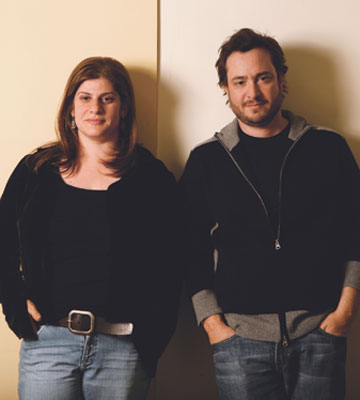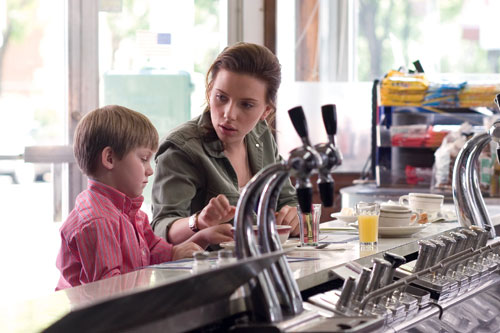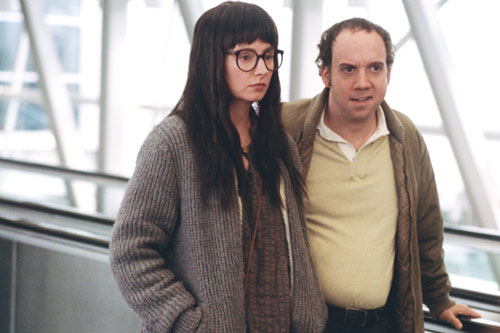BY SYLVIANE GOLD
 (Photo by Patrick Harbron)
(Photo by Patrick Harbron)Like most married couples, Robert Pulcini and Shari Springer Berman have trouble articulating exactly how the relationship works—especially since, in addition to being married, they're also a directing team.
But Pulcini took a shot at it during a joint interview as they were putting the finishing touches on The Nanny Diaries prior to its release in September. "We both do everything, but I take the lead in some areas and she takes the lead in others," he says.
And then Springer Berman took a shot at it. "The first thing you need is a shared esthetic," she says. "There are some movies I'll love that he won't, and vice versa. But more often, there'll be a weird thing in a movie that nobody in the theater will laugh at, and both of us will start laughing. If we didn't have a shared esthetic, we couldn't work together. That's our foundation."
So when Miramax sent them The Nanny Diaries as a possible screenwriting project, Pulcini's first reaction was: "They've got to be kidding," but Springer Berman was intrigued.
The team had earned a slew of critics' awards and festival prizes in 2003 for writing and directing American Splendor, the gritty, offbeat homage to comic-book auteur Harvey Pekar. Pulcini thought the slick, catty book about a rich family's nanny seemed to live in an alternate universe.
On the other hand, it was a universe Springer Berman had visited before heading to Columbia University's graduate film program (which is where the two met). Among her many jobs was a stint as personal assistant to a wealthy Fifth Avenue couple. And Nanny Diaries was about a nurse's daughter who finds herself working in that social setting.
To Springer Berman, the book's jaundiced view of upper crust New York presented a rare opportunity. "We're big fans of movies like My Man Godfrey and Trouble in Paradise," she explains. "They're movies that dealt with class in a light, fun way, but a smart way. I felt like there was potential to try to do something like that.
 SWEET JOB: Actors Scarlett Johansson and Nicholas Art in a view from
SWEET JOB: Actors Scarlett Johansson and Nicholas Art in a view from
The Nanny Diaries. (Photo Credit: K.C. Bailey/The Weinstein Co.) TWO OF A KIND: Paul Gaiamatti plays curmudgeonly cartoonist Harvey Pekar and
TWO OF A KIND: Paul Gaiamatti plays curmudgeonly cartoonist Harvey Pekar and
Hope Davis is his wife Joyce in American Splendor. (Photo Credit: John Clifford)And it isn't as if they'd never been interested in purely commercial material. The first script they wrote together, while still at Columbia, was a Grisham-style thriller. And as they hashed it out, and other pieces fell into place, they decided Nanny Diaries would be their next project. Heading in an unlikely new direction would be smarter than trying to top the quirky success of American Splendor, and, Pulcini says, they liked the idea "of making a valentine to the city we live in." Adds Springer Berman, "There's no greater set, and, I'm sorry, you cannot substitute Toronto or Vancouver for New York."
So they traded the dingy Cleveland locales of Pekar's lackluster existence for the elegant Park Avenue digs of Mr. and Mrs. X. Splendor's budget of under $3 million was multiplied by a factor of about 10. And their young, non-union Splendor crew was supplanted by a fully experienced, DGA New York team that, Pulcini says, they fell in love with.
However, when Springer Berman and Pulcini envisioned Nanny Annie and her young charge Grayer cavorting in Central Park or exploring other Manhattan locations, they hadn't really imagined the other cameras that show up when you're shooting in New York and your lead actress is a paparazzi magnet like Scarlett Johansson.
Dealing with the paparazzi turned out to be the hardest part of the shoot. "There's very little you can do when an actor's trying to focus and there are people tucked away everywhere snapping photos," says Pulcini.
The directors were particularly concerned the day Johansson was to be hoisted 100 feet over Tribeca for a Mary Poppins moment. Johansson was nervous, the crane and camera moves were complex, and the directors wanted the scene to be a little bit of a surprise. "Lo and behold, it took 10 minutes for pictures of her with the red umbrella to be everywhere on the Internet," laments Springer Berman.
You'd think things would get easier when you go from an underfinanced indie to a major studio film, from a 24-day shoot to a 48-day schedule. But, Pulcini says, "It was just as hard."
In part, the problems they encountered were their own doing. Playing with the form on American Splendor, they found the toughest challenge was navigating smoothly among the film's three levels of reality: the documentary footage from Pekar's life, the biopic scenes performed by the actors, and the hand-drawn animation and comic-book panels.
The directors set themselves similar problems in Nanny Diaries by giving Johansson's character an anthropological turn of mind. As she encounters various types of New Yorkers, they turn into museum dioramas, like the ones she and Grayer see at the American Museum of Natural History.
Some of the dioramas were built and shot on a soundstage, while actors with waxy makeup and wig-like hairdos posed as statues in front of green screens. But the really difficult dioramas were the ones that appear to flow right out of the movie action. In one, an actress in trendy clothes on a downtown street freezes in full stride as her surroundings morph into a satiric display box for a "SoHo fashionista."
They carefully storyboarded every aspect of the sequence and used a motion-control camera. "We had to do a variety of plates and a variety of green screen work," Pulcini says. "And we had to have a real metal frame to represent where the diorama would be, so every time we did these moves we'd know where the edge was. We were always measuring."
It would have been easier just to cut from the live-action scene to the diorama, but, he says, "we wanted it to have the elegance of that effect."
Their meticulous attention to such matters might seem unusual for filmmakers who started out recording reality in documentaries. (Their first two films were Off the Menu: The Last Days of Chasen's and The Young and the Dead, about a New Age cemetery entrepreneur.) But their non-fiction experience, they say, serves them well no matter what the project. "Rather than manipulating the world to fit our vision, we find ways to accommodate our vision to the world," says Springer Berman. "We're not rigid. We want to listen." They even chucked their own Nanny dialogue when the repartee among the actors in a dinner party scene sounded more natural.
By the time they arrive on the set, they have already resolved most of their arguments over the script. But the revising continues. "We're writing even as we're filming, to clarify things. You want to eliminate as many questions as you can."
But as directors working together, they have the most fights in the editing room when Pulcini moves over to run the editing equipment, serving as both editor and co-director, while Springer Berman stays solidly in the director's chair supervising the process. "And sometimes," she says with a laugh, "I have to, you know, pull rank. I have to remind him that I am the director. At that moment."